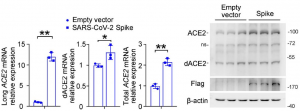A group from Second Military Medical University, Shanghai, China, etc. has reported that SARS-CoV-2 Spike enhances ACE2 expression in bronchial epithelium.
https://www.ncbi.nlm.nih.gov/pmc/articles/PMC8254647/
It was found that the expression of ACE2, the receptor of SARS-CoV-2, was significantly increased in bronchial epithelial cells (BEAS-2B cells) by transfection with SARS-CoV-2 Spike protein. In the figure below, BEAS-2B cells were transfected with empty vector, or SARS-CoV-2-Spike protein constructs, and then the expression of long ACE2, dACE2 and total ACE2 was detected by qRT-PCR. BEAS-2B cells were transfected with empty vector or S protein, and the expression of long ACE2 and dACE2 was detected by Western blot using C-terminal anti-ACE2 antibody (β-actin was used as internal control).
As SARS-CoV-2 S protein activates IFN-stimulated genes (ISGs) expression, it was examined that whether S protein could induce ACE2 expression by activating JAK-STAT signaling. The phosphorylation and activation of STAT1 and STAT2 were analyzed in Spike protein-overexpressed BEAS-2B cells, and it was found that Spike protein could enhance the phosphorylation of STAT1 at tyrosine 701 and STAT2 at tyrosine 690, thus contributing for their activation. Furthermore, using Fludarabine to inhibit STAT1 activation, the induced long ACE2 expression by Spike protein overexpression was greatly downregulated in BEAS-2B cells. Together, it was concluded that SARS-CoV-2 S protein could induce the receptor long ACE2 expression by activating IFN effector JAK-STAT signaling.

